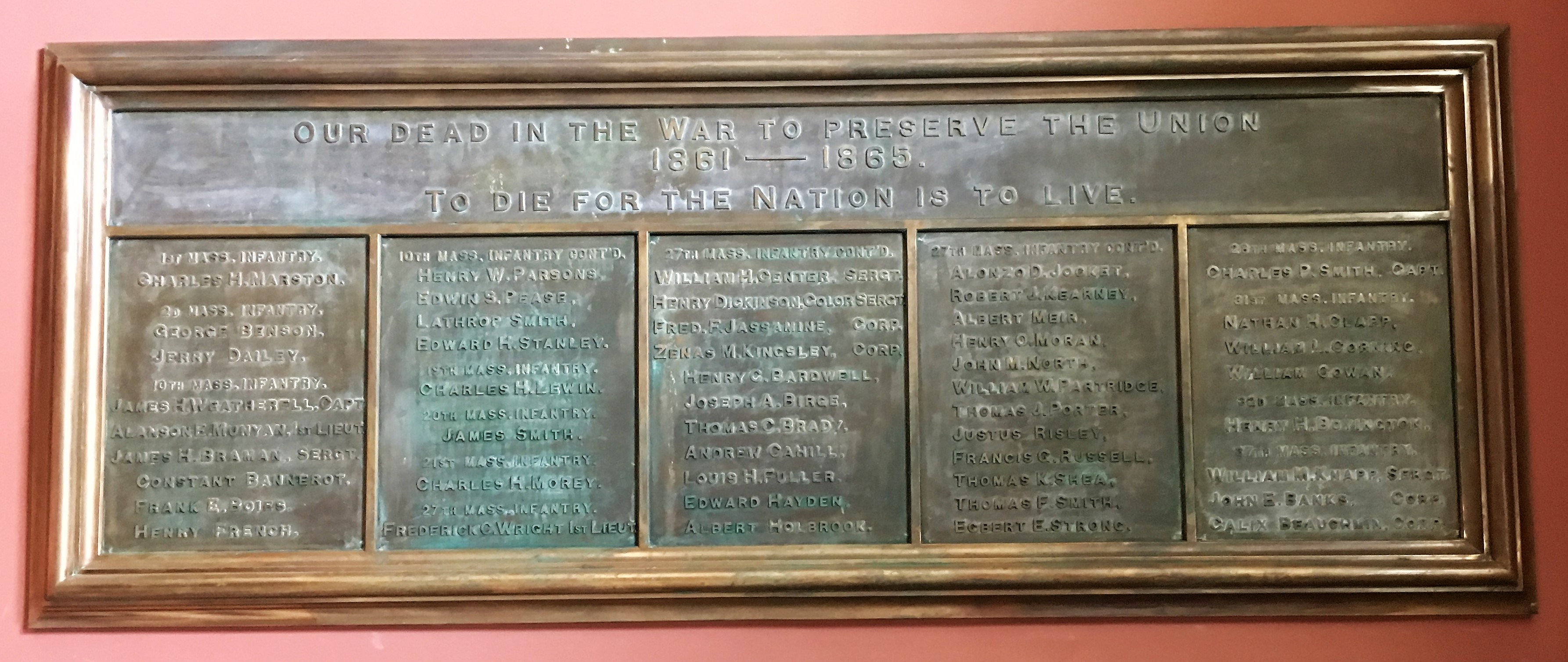
Location: Memorial Hall, 240 Main Street, Northampton
Coordinates: 42°19’03.1″N 72°37’57.4″W
Date dedicated: Memorial Hall, March 1874; Sculptures and tablets September 1888
Architect/contractor/sculptor: James W. McLaughlin, architect; L.N. Granger, contractor; Melzar Hunt Mosman, sculptor (statues)
Number of names: 90 men who died in the war
 The architect of the building, James W. McLaughlin (1834-1923) of Cincinnati, was a Civil War veteran who served as a lieutenant on the staff of Gen. John C. Fremont in the first year of the war. He is recognized as Cincinnati’s most important architect of the 19th century and his impressive list of works includes museums, libraries, churches, courthouses and mansions. He was mainly known for working in the Romanesque style but typically gave his buildings a “personal twist, rather tough but handsome.” This apparently translated into buildings with minimal ornamentation (for the day), focusing on geometric forms.[1]
The architect of the building, James W. McLaughlin (1834-1923) of Cincinnati, was a Civil War veteran who served as a lieutenant on the staff of Gen. John C. Fremont in the first year of the war. He is recognized as Cincinnati’s most important architect of the 19th century and his impressive list of works includes museums, libraries, churches, courthouses and mansions. He was mainly known for working in the Romanesque style but typically gave his buildings a “personal twist, rather tough but handsome.” This apparently translated into buildings with minimal ornamentation (for the day), focusing on geometric forms.[1]
Planning for the building began in 1867. After years spent in securing funding and the appropriate location, ground was broken in 1872 and the building completed in 1873.[2] It originally served as a combined library and memorial hall. The handsome entry hall with its marble floors and rich paneling in walnut and ash was meant to house tablets featuring the names of the 90 men from Northampton who died in the war. Due to fundraising difficulties, this was not accomplished until the fall of 1888. At that time the marble tablets were installed and the bronze statues of a soldier and sailor were installed in front of the building.
The statues flanking the front door are collectively known as “Northampton Remembers.” They were sculpted by Melzar Hunt Mosman (1843-1926) and cast at the Ames Foundry in Chicopee. Mosman had served in North Carolina and Mississippi and nearly died of fever during the Siege of Vicksburg. A duplicate of the sailor, along with a similar but slightly modified pose of the infantryman, can be found in Saugus. And an identical copy of Mosman’s infantryman can be found on the monument in Kingston. Mosman was responsible for casting at his foundry many other monuments in Massachusetts which were sculpted by other artists.
At the beginning of the war, Northampton’s home militia company was Company C of the 10th Massachusetts Infantry which was mustered into federal service for a term of three years. Capt. Joseph B. Parsons led that company and was eventually promoted to lieutenant colonel and command of the 10th Massachusetts. James H. Wetherell of Northampton took his place as captain of the Northampton company. The regiment saw its worst fighting during the Battle of Spotsylvania in May 1864 during which Captain Wetherell was badly wounded. He lingered on for more than a month at a hospital in Georgetown but died of his wounds on June 20, 1864–one day after the unit was relieved from duty at the end of its term. The return of Company C to Northampton was therefore somewhat melancholy as they bore their fallen captain with them.[3]


[1] Biographical Dictionary of Cincinnati Architects, 1788-1940
[2] Jill M. Walton, “Northampton Local Monuments: Testament to an Enduring Historical Legacy” Historical Journal of Massachusetts Volume 33, No. 1 (Winter 2005), 59-60.
[3] Alfred S. Roe, The Tenth Regiment, Massachusetts Volunteer Infantry, 1861-1864, (Springfield: Tenth Regiment Veteran Association, 1909), 385.

